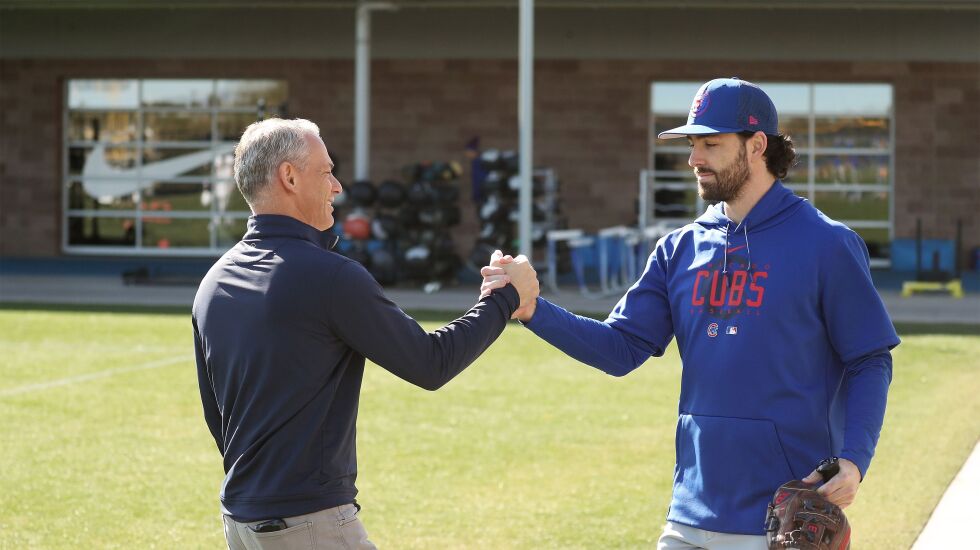
MESA, Ariz. — There’s no one way to build a team. Look at the Phillies, who spent big on the free-agent market, loaded up their roster with sluggers and let the defense sort itself out later. They ended their playoff drought with a trip to the World Series last year.
The Cubs have taken a different approach, both with their last championship team and with the current squad.
“When we’ve been at our best, certainly we’ve been very good defensively,” president of baseball operations Jed Hoyer said. “So up the middle, that’s certainly a priority. With any offseason, you are dealing with what’s available, you certainly may have a certain desire to build a team a certain way. But if that’s not available, you’re going to pivot. So being nimble is important.
“But that said, being strong defensively, taking care of the ball, playing clean baseball, that’s winning baseball.”
The 2016 World Series champions had an intimidating lineup, but they also had the best defensive efficiency ratio (.728) in MLB that season, leading by a comfortable margin.
“I don’t think defense ever gets enough credit,” said manager David Ross, who was on that championship team. “Fans are excited about three-run home runs, great pitching is fun. But I love athletic play, I love diving plays up the middle, I love a sick double play — guy backhands the ball and flips it, you turn it — that’s energizing to me.”
Reflecting on 2016, Ross pointed to Javy Baez’s “Swiss army knife” role, playing third base, second base and shortstop. He emphasized the value of a “legit first baseman” like Anthony Rizzo, who could turn a bad throw into an out at first.
“It’s a complete unit, everybody works together,” Ross said. “And that was the fun thing about that ’16 team — it didn’t matter who you put where, whether Ben [Zobrist] was at second or Javy was at second. Moving guys around in that way was a lot of fun. So hopefully we can have some similarities to that this year.”
This year’s team, as constructed, has its limits. It doesn’t have the offensive pop of the 2016 team, although the Cubs did add some power with the signings of Trey Mancini and Edwin Rios. The club is counting on bounce-back years from several players.
The rotation has depth, but to compete for another World Series, the Cubs likely will have to add to the top of the rotation in the coming years.
They are projected to finish third in the division, behind the Cardinals and Brewers, who last year won 93 and 86 games, respectively.
“There were definitely years that the projections haven’t liked us, or haven’t liked us as much as we might,” Hoyer said at the beginning of spring training. “But ultimately, our job is to prove those wrong.”
Over the offseason, the Cubs stayed true to prioritizing up-the-middle defense. And with an obliging free-agent market, it became this team’s strong suit. Their additions, many with strong defensive track records and room for offensive growth, reflected Hoyer’s team-building philosophy.
With Dansby Swanson, the Cubs landed one of the two Gold Glove winners in the Big 4 free-agent shortstop group and a player who made building off his first All-Star season a priority
“The savvy and the gloves and the mental awareness that our guys are going to have up the middle this year should be a lot of fun for us,” Ross said of Swanson and second baseman Nico Hoerner.
The Cubs also jumped on an opportunity created by the Dodgers’ depth and 2019 MVP Cody Bellinger’s offensive decline in recent seasons.
“The defensive side didn’t waiver,” Dodgers manager Dave Roberts said earlier this spring. “And he was a plus-defender through the good and the bad with his bat.”
That consistency, and the belief that a fully healthy offseason and change of scenery could give Bellinger an offensive boost, made him a target for Hoyer when the Dodgers non-tendered him in November.
To complete that up-the-middle defensive revamp, the Cubs signed two-time Gold Glove catcher Tucker Barnhart to pair with Yan Gomes behind the plate, unfazed by the lost offensive output from Willson Contreras’ departure.
Hoyer and his team certainly aren’t anti-offense, and they still have work to do to create another perennial playoff contender. This team can be seen as the foundation — built on defense, because in a game as fickle as baseball, defense is the best bet for consistency.







